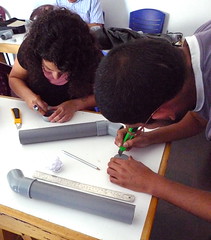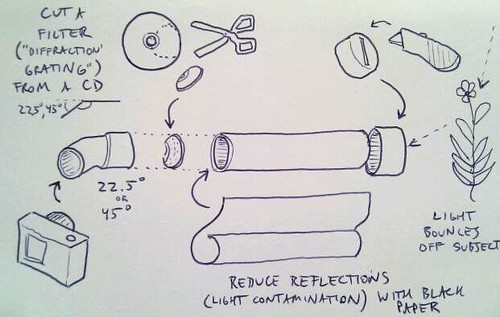 ##How to build and use a spectrometer (draft)##
Collect some samples from the beach, water and sediment and solids, and build a spectrometer, and try taking some photos through it. They're really pretty easy to make out of PVC tubes; a more formal guide is in the making but here are some sketches which get across the basics. Experiment to see how much detail you can get in your spectra -- and how black you can make the background:
##How to build and use a spectrometer (draft)##
Collect some samples from the beach, water and sediment and solids, and build a spectrometer, and try taking some photos through it. They're really pretty easy to make out of PVC tubes; a more formal guide is in the making but here are some sketches which get across the basics. Experiment to see how much detail you can get in your spectra -- and how black you can make the background:
 Spectrometry works best when you shine a bright, full-spectrum light (like the sun) *through* a sample. But sometimes you can't do that. You can also try pointing the spectrometer at an object which light is bouncing off of. In general, you should take a calibration image of some very white surface, like a piece of white paper, in the same light, at more or less the same time. This gives you a baseline to compare your sample's spectrum against. If you're using a container to hold your sample, your calibration spectrum should be taken through that container too -- to measure everything *except* your sample.
Spectrometry works best when you shine a bright, full-spectrum light (like the sun) *through* a sample. But sometimes you can't do that. You can also try pointing the spectrometer at an object which light is bouncing off of. In general, you should take a calibration image of some very white surface, like a piece of white paper, in the same light, at more or less the same time. This gives you a baseline to compare your sample's spectrum against. If you're using a container to hold your sample, your calibration spectrum should be taken through that container too -- to measure everything *except* your sample.
 To get a really clear, precise spectrum, you can use 2 razor blades to make a very very narrow slit. This should improve your 'resolution'. Use black electrical tape or duct tape to hold them in place:
To get a really clear, precise spectrum, you can use 2 razor blades to make a very very narrow slit. This should improve your 'resolution'. Use black electrical tape or duct tape to hold them in place:
 So the theory is that if you shine strong UV light ([buy here](http://www.google.com/search?client=safari&rls=en&q=uv+light&ie=UTF-8&oe=UTF-8#q=uv+light&hl=en&client=safari&rls=en&prmd=ivns&source=univ&tbs=shop:1&tbo=u&ei=RbJJTd-YJcaqlAfzz90f&sa=X&oi=product_result_group&ct=title&resnum=3&ved=0CFcQrQQwAg&biw=1159&bih=661&fp=1)) on the samples, they should glow in a very specific color. that should make a spike at a certain point on the spectrum, though you may need to compare it with a spectrum taken *without* UV, to see the spike. The spike *should* be visible in normal light, so any camera should do.
Even just building a spectrometer is a good experience and if we continue to follow up on spectrometer research the skills and nuances of building one will come in handy even if we can't identify PAHs with them.
###Additional notes on spectrometry for the [spectrometer tool](/tool/spectrometer)###:
Color algorithms to automatically recognize wavelengths:
* http://stackoverflow.com/questions/1678457/best-algorithm-for-matching-colours/1678498
* http://stackoverflow.com/questions/1720528/what-is-the-best-argorithm-for-finding-the-closest-color-in-an-array-to-another-c
* http://www.velocityreviews.com/forums/t430790-rgb-wavelength-intensity.html
* http://codingmess.blogspot.com/2009/05/conversion-of-wavelength-in-nanometers.html=
So the theory is that if you shine strong UV light ([buy here](http://www.google.com/search?client=safari&rls=en&q=uv+light&ie=UTF-8&oe=UTF-8#q=uv+light&hl=en&client=safari&rls=en&prmd=ivns&source=univ&tbs=shop:1&tbo=u&ei=RbJJTd-YJcaqlAfzz90f&sa=X&oi=product_result_group&ct=title&resnum=3&ved=0CFcQrQQwAg&biw=1159&bih=661&fp=1)) on the samples, they should glow in a very specific color. that should make a spike at a certain point on the spectrum, though you may need to compare it with a spectrum taken *without* UV, to see the spike. The spike *should* be visible in normal light, so any camera should do.
Even just building a spectrometer is a good experience and if we continue to follow up on spectrometer research the skills and nuances of building one will come in handy even if we can't identify PAHs with them.
###Additional notes on spectrometry for the [spectrometer tool](/tool/spectrometer)###:
Color algorithms to automatically recognize wavelengths:
* http://stackoverflow.com/questions/1678457/best-algorithm-for-matching-colours/1678498
* http://stackoverflow.com/questions/1720528/what-is-the-best-argorithm-for-finding-the-closest-color-in-an-array-to-another-c
* http://www.velocityreviews.com/forums/t430790-rgb-wavelength-intensity.html
* http://codingmess.blogspot.com/2009/05/conversion-of-wavelength-in-nanometers.html= ##How to build and use a spectrometer (draft)##
Collect some samples from the beach, water and sediment and solids, and build a spectrometer, and try taking some photos through it. They're really pretty easy to make out of PVC tubes; a more formal guide is in the making but here are some sketches which get across the basics. Experiment to see how much detail you can get in your spectra -- and how black you can make the background:
##How to build and use a spectrometer (draft)##
Collect some samples from the beach, water and sediment and solids, and build a spectrometer, and try taking some photos through it. They're really pretty easy to make out of PVC tubes; a more formal guide is in the making but here are some sketches which get across the basics. Experiment to see how much detail you can get in your spectra -- and how black you can make the background:
 Spectrometry works best when you shine a bright, full-spectrum light (like the sun) *through* a sample. But sometimes you can't do that. You can also try pointing the spectrometer at an object which light is bouncing off of. In general, you should take a calibration image of some very white surface, like a piece of white paper, in the same light, at more or less the same time. This gives you a baseline to compare your sample's spectrum against. If you're using a container to hold your sample, your calibration spectrum should be taken through that container too -- to measure everything *except* your sample.
Spectrometry works best when you shine a bright, full-spectrum light (like the sun) *through* a sample. But sometimes you can't do that. You can also try pointing the spectrometer at an object which light is bouncing off of. In general, you should take a calibration image of some very white surface, like a piece of white paper, in the same light, at more or less the same time. This gives you a baseline to compare your sample's spectrum against. If you're using a container to hold your sample, your calibration spectrum should be taken through that container too -- to measure everything *except* your sample.
 To get a really clear, precise spectrum, you can use 2 razor blades to make a very very narrow slit. This should improve your 'resolution'. Use black electrical tape or duct tape to hold them in place:
To get a really clear, precise spectrum, you can use 2 razor blades to make a very very narrow slit. This should improve your 'resolution'. Use black electrical tape or duct tape to hold them in place:
 So the theory is that if you shine strong UV light ([buy here](http://www.google.com/search?client=safari&rls=en&q=uv+light&ie=UTF-8&oe=UTF-8#q=uv+light&hl=en&client=safari&rls=en&prmd=ivns&source=univ&tbs=shop:1&tbo=u&ei=RbJJTd-YJcaqlAfzz90f&sa=X&oi=product_result_group&ct=title&resnum=3&ved=0CFcQrQQwAg&biw=1159&bih=661&fp=1)) on the samples, they should glow in a very specific color. that should make a spike at a certain point on the spectrum, though you may need to compare it with a spectrum taken *without* UV, to see the spike. The spike *should* be visible in normal light, so any camera should do.
Even just building a spectrometer is a good experience and if we continue to follow up on spectrometer research the skills and nuances of building one will come in handy even if we can't identify PAHs with them.
###Additional notes on spectrometry for the [spectrometer tool](/tool/spectrometer)###:
Color algorithms to automatically recognize wavelengths:
* http://stackoverflow.com/questions/1678457/best-algorithm-for-matching-colours/1678498
* http://stackoverflow.com/questions/1720528/what-is-the-best-argorithm-for-finding-the-closest-color-in-an-array-to-another-c
* http://www.velocityreviews.com/forums/t430790-rgb-wavelength-intensity.html
* http://codingmess.blogspot.com/2009/05/conversion-of-wavelength-in-nanometers.html=
So the theory is that if you shine strong UV light ([buy here](http://www.google.com/search?client=safari&rls=en&q=uv+light&ie=UTF-8&oe=UTF-8#q=uv+light&hl=en&client=safari&rls=en&prmd=ivns&source=univ&tbs=shop:1&tbo=u&ei=RbJJTd-YJcaqlAfzz90f&sa=X&oi=product_result_group&ct=title&resnum=3&ved=0CFcQrQQwAg&biw=1159&bih=661&fp=1)) on the samples, they should glow in a very specific color. that should make a spike at a certain point on the spectrum, though you may need to compare it with a spectrum taken *without* UV, to see the spike. The spike *should* be visible in normal light, so any camera should do.
Even just building a spectrometer is a good experience and if we continue to follow up on spectrometer research the skills and nuances of building one will come in handy even if we can't identify PAHs with them.
###Additional notes on spectrometry for the [spectrometer tool](/tool/spectrometer)###:
Color algorithms to automatically recognize wavelengths:
* http://stackoverflow.com/questions/1678457/best-algorithm-for-matching-colours/1678498
* http://stackoverflow.com/questions/1720528/what-is-the-best-argorithm-for-finding-the-closest-color-in-an-array-to-another-c
* http://www.velocityreviews.com/forums/t430790-rgb-wavelength-intensity.html
* http://codingmess.blogspot.com/2009/05/conversion-of-wavelength-in-nanometers.html=